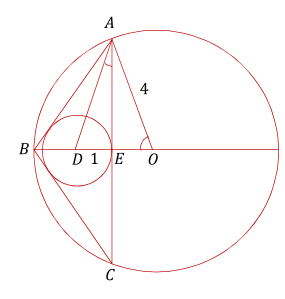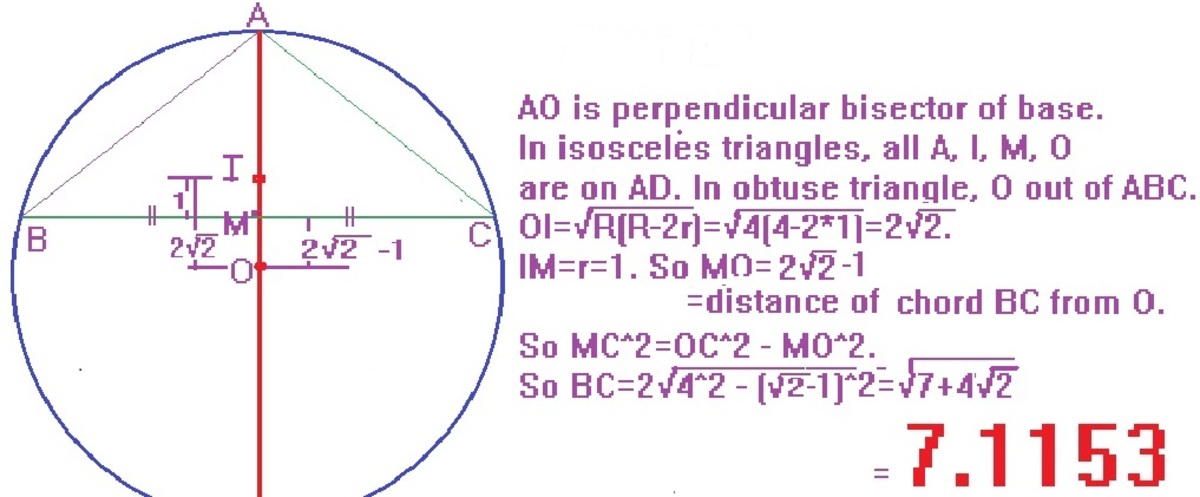Ins and Outs
 An obtuse isosceles triangle has an incircle radius
r
=
1
and a circumradius
R
=
4
. Find the size of its largest side.
An obtuse isosceles triangle has an incircle radius
r
=
1
and a circumradius
R
=
4
. Find the size of its largest side.
Note: Drawing is not to scale.
The answer is 7.115.
This section requires Javascript.
You are seeing this because something didn't load right. We suggest you, (a) try
refreshing the page, (b) enabling javascript if it is disabled on your browser and,
finally, (c)
loading the
non-javascript version of this page
. We're sorry about the hassle.
4 solutions
what if the perpendicular lies to the right of O as in this?

Log in to reply
Yes, you are right. I was motivated by the figure to take that point outside the figure, thought of doing that by placing it inside the triangle too but the first one got me right so didn't. I will update the solution to show both the possible lengths once the answer is updated.
If angles B and C are equal, then the fact that R = 4 gives us a = 8 sin A = 8 sin ( π − 2 C ) = 8 sin 2 C while the fact that r = 1 gives us a 2 = tan 2 1 C and hence 1 = 4 tan 2 1 C sin 2 C Putting x = tan 2 1 C , we deduce that ( 1 + x 2 ) 2 1 7 x 4 − 1 4 x 2 + 1 = 1 6 x 2 ( 1 − x 2 ) = 0 and hence x = 1 7 7 ± 4 2 When x = 1 7 7 + 4 2 all the angles in the triangle are acute. When x = 1 7 7 − 4 2 the angle A is obtuse, and the longest side is a = 7 . 1 1 5 2 9 .
 In the figure,
D
is a center of the incircle and
O
center of the circumcircle of triangle
A
B
C
with
A
B
=
B
C
.
In the figure,
D
is a center of the incircle and
O
center of the circumcircle of triangle
A
B
C
with
A
B
=
B
C
.
Let’s have γ = ∠ D A E = ∠ D A B . Angle A B O = 9 0 ∘ − 2 γ . Angle A O B = 2 × ( 9 0 ∘ − ∠ A B O ) = 4 γ .
From triangle A E O , A E = 4 × s i n ( 4 γ ) = 8 s i n ( 2 γ ) c o s ( 2 γ ) = 1 6 s i n ( γ ) c o s ( γ ) ( 1 − 2 s i n 2 ( γ ) ) .
From triangle A E D , A E = t a n ( γ ) 1 .
Combining the two and simplifying: s i n 2 ( γ ) ( 1 − 2 s i n 2 ( γ ) ) = 1 6 1
Solving: s i n 2 ( γ ) = 8 2 − 2
γ = 1 5 . 7 ∘ , 4 γ = 6 2 . 8 ∘
A E = 4 × s i n ( 4 γ ) = 3 . 5 5 7 6 . So the longest side of triangle A B C is double that or approximately 7 . 1 1 5 .
It is easy to show that sides A B = B C = 2 × 4 × s i n ( 2 γ ) = 4 . 1 7 are smaller.
what if the perpendicular lies to the right of O as in this?


OR
D i s t a n c e b e t w e e n t w o c e n t e r s = R ( R − 2 r ) = 2 2 . ∴ d i s t a n c e b e t w e e n c i r c u m c e n t e r a n d m i d p o i n t o f t h e b a s e = 2 2 − 1 = h a l f t h e b a s e w h i c h i s a l s o t h e c h o r d o f c i r c u m c i r c l e . ∴ h a l f b a s e = 4 2 − ( 2 2 − 1 ) 2 . F o r a n o b t u s e i s o s c e l e s t r i a n g l e t h e b a s e i s t h e l a r g e s t s i d e = 2 ∗ 4 2 − ( 2 2 − 1 ) 2 = 7 . 1 1 5 3 .
S i n c e t h e v e r t i c a l a n g l e o f D e l t a is o b t u s e => T h e c i r c u m c e n t e r w i l l l i e o n l y o u t s i d e t h e t r i a n g l e .